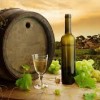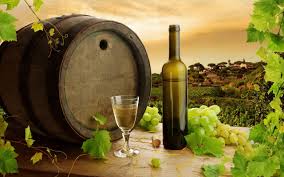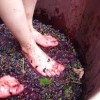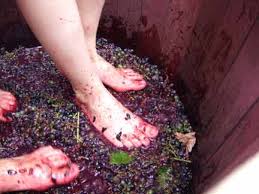
Posted on 01 June 2014. Tags: basic steps of wine making, blending, bottling, crush grapes, fermentation, grape concentrate, grapes, harvest grapes, home brewing stores, remove stems, sulfites, wine, wine connoisseur, wine kit, wine making, wine making steps, yeast

If you are a true wine connoisseur, the next step in appreciating a fine wine may be to make your own wine at home. While the process may seem to be complicated, wine can be made rather easily at home. Before beginning the process of making your own wine at home it is important to understand the basic steps of wine making.
In order to make wine at home you will need either grape concentrate or grapes. If you have a sufficient growing area, you may choose to grow your own grapes and make wine from that. If you choose to use grape concentrate, keep in mind that you will need to use high quality grape concentrate. This can be purchased online as well as in wine and home brewing stores. In addition, you will need yeast and brewing equipment. If this is your first batch of wine you may wish to consider purchasing a wine kit rather than buying all of your equipment separately. After you have had a chance to experiment with making wine at home and decided whether it is an endeavor you wish to continue you might then begin accumulating various pieces of equipment for brewing larger batches of wine.
Five to Eight Basic Steps
There are five to eight basic steps involved in the process of making wine, depending on whether you are using grapes or concentrate.
(1) If you are using grapes then the fruit will obviously need to be harvested first.
(2) After the grapes have been harvested, you will then need to remove the stems from the grapes. This is an absolutely essential step as very bitter tannins are contained in the stems that can have a heavy influence on the wine.
(3) After the stems have been removed, the skins of the grapes will then need to be broken in order to release the juice from the fruit. There are certainly many different ways in which to do this. Crushing is the preferred method for most winemakers. The degree to which the fruit is crushed will have an impact on the resulting wine. If your goal is to create a wine that has a fruity aroma then you may wish to leave the berries almost completely intact.
(4) The next step is known as the primary fermentation. During this step the yeast cells contained in the wine will feed on the sugars. Alcohol and carbon dioxide is produced as a result. In some cases, you may wish to add additional yeast. This helps to ensure a stable and consistent conversion which may not be the case if you rely solely on the yeast that is found on the fruit itself.
(5) After the primary fermentation, more juice will need to be extracted from the fruit. It should be noted that the juice that is extracted in this step is typically not as high of a quality as the juice that is extracted during the crushing phase. This is because the juice that is obtained during crushing, known as free run juice, has had less contact with the stems and skins. This does not mean that press juice is useless; however. Even large wineries may choose to use press juice in order to increase their yield.
(6) A secondary fermentation occurs after the pressing, at the same time as the wine is aging. As the winemaker, it will be up to you to determine how long the wine should ferment.
(7) Blending is an optional part of the process; however, one which can assist you in creating a highly customized wine. Blending is most commonly used in order to improve two or more batches which may be slightly lacking.
(8) The last step of the process is bottling. The wine is poured into bottles and at times you may wish to add sulfites in order to help end fermentation as well as to preserve the wine. Finally, the bottle of wine is sealed with a cork.
Making wine at home can be a very enjoyable experience. As you learn more about the process of making wine, you will likely gain a more thorough appreciation of wine.
Posted in Winemaking

Posted on 26 May 2014. Tags: fermentation, filter, grape concentrate, grapes, home wine making, wine, wine making, winemaking

Real Grapes or Grape Concentrate
One of the great advantages of making your own wine is that you are able to take control of as much of the process as you want. If you want to grow and harvest your own grapes or any other kind of fruit and produce wine you can control every aspect of the process. If, on the other hand, you choose to purchase grape concentrate, you can begin making your wine from that point on. Making wine is largely about making a number of different decisions and taking various factors into consideration. Each factor and each decision will have an impact on your final wine.
Grape Clusters or De-Stem
One of the first choices you will need to make if you elect to make grape wine and use fruit in order to do it instead of concentrate is whether you want to de-stem the grapes or use the entire cluster. When making this decision it is important to keep in mind that it really does make a difference. If you decide to use the whole cluster then you will find that your wine has a certain flavor and even nuance that is not present if you de-stem the grapes first. This flavor may or may not be appealing to you. Some people describe it as somewhat ‘green.’ If you like that sort of flavor, then using a whole cluster is an excellent choice. A number of very good, award winning wines are produced using the entire cluster. If; however, you do not think you would like that flavor, then it is best to go ahead and de-stem the grapes before you use them for your wine.
Barrel or Tank Fermentation
Another choice you will have to make is how you want to ferment the must. Yes, there are choices to make here as well. You have two basic choices. You can either ferment in a barrel or a tank. Most winemakers prefer to ferment using a tank. This gives you greater control over the process because the sleeves on the tank give you the option to either heat or cool the must. For example, in the beginning of the fermentation process you may wish to ensure the tanks are cool in order to extract the color from the grape skins. This can also help to stabilize the wine. Of course, you can also choose to ferment your wine in a barrel. This is a popular method when producing white wines because it tends to give them some character that might not be possible from tank fermentation. In the end, it is really up to you and your personal choice, but you will need to make this decision before you produce your first batch of wine.
Yeast Choices
You will also need to give some thought to the types of yeast that you wish to use. Most beginning winemakers are not aware of the fact that grapes picked straight from the vineyard actually have yeast on them. These are naturally occurring yeasts. As a result, you may choose not to add any additional yeast to the fermentation mix. In this case, you can allow the natural or native yeasts to work on their own. The one downside to this problem is that you may run into a problem known as a stuck fermentation. This is when the yeast reaches a certain point and then it just simply stops. Generally, yeasts that are created in the lab will be more stable. Of course, there is a downside to this as well. Many winemakers feel that lab created yeasts are lacking in flavor when compared to natural yeasts.
If you do choose to use natural yeasts, you will need to be prepared to handle a stuck fermentation in the event that it does occur. Adding a yeast nutrient or energizer can often help to combat this problem by providing the natural yeasts the ‘kick’ they need to finish the fermentation process.
Filter or Not to Filter
Finally, you will need to give some thought to whether you wish to filter or not filter your wine. There is no set rule regarding this matter. You may find that a wine that has been unfiltered will have a great amount of richness; however, do be aware that there are bacterial issues which may arise if you choose not to filter your wine. In addition, wines that have not been filtered tend to have a cloudier appearance than those that have been filtered.
Posted in Winemaking






